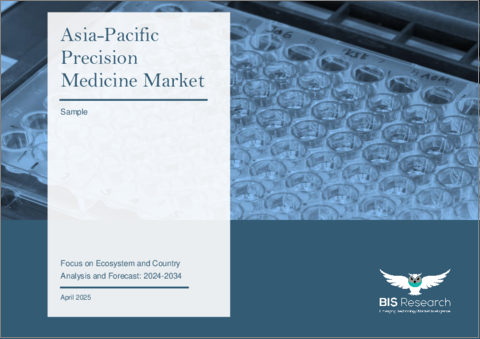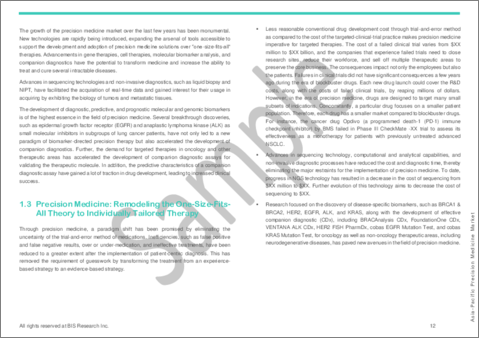|
|
市場調査レポート
商品コード
1716264
アジア太平洋の精密医療市場:エコシステムと国別 - 分析と予測(2024年~2034年)Asia-Pacific Precision Medicine Market: Focus on Ecosystem and Country - Analysis and Forecast, 2024-2034 |
||||||
カスタマイズ可能
|
|||||||
| アジア太平洋の精密医療市場:エコシステムと国別 - 分析と予測(2024年~2034年) |
|
出版日: 2025年05月01日
発行: BIS Research
ページ情報: 英文 75 Pages
納期: 1~5営業日
|
全表示
- 概要
- 図表
- 目次
アジア太平洋の精密医療の市場規模は、2024年の404億4,000万米ドルから2034年には1,589億2,000万米ドルに達すると予測され、2024年から2034年の予測期間中のCAGRは14.67%と見込まれています。
アジア太平洋地域の精密医療産業は、遺伝子研究、診断、標的医薬品の開発によって牽引されています。慢性疾患の罹患率の増加、デジタルヘルスソリューションの導入、患者の個別ケア重視の高まりが、この拡大の主な推進力となっています。オーダーメイド医薬品の開発は、政府の取り組みや共同研究提携によって加速しており、患者の治療成績が向上しています。さらに、バイオマーカー、次世代シーケンシング、AIを活用した診断の普及により、腫瘍学、循環器学、珍しい疾患の治療が劇的に変化しています。ヘルスケア・インフラへの継続的な投資と、個別化治療の利点に関する一般知識の増加は、多くの医療現場における精密医療の迅速な導入に寄与するもう2つの要因です。これらの開発により、アジア太平洋地域は最先端の医学研究と技術の活気ある中心地として確立されつつあり、その結果、より個別化された治療計画が成功し、正確で患者中心の治療へと向かっています。
| 主要市場統計 | |
|---|---|
| 予測期間 | 2024年~2034年 |
| 2024年の評価額 | 404億4,000万米ドル |
| 2034年の予測 | 1,589億2,000万米ドル |
| CAGR | 14.67% |
精密医療は、アジア太平洋におけるヘルスケア革新の重要な推進力として急速に台頭しており、既成の治療パラダイムから、より個別化された患者中心の治療へと変化をもたらしています。ゲノミクス、人工知能、デジタルヘルス技術の開発により、患者一人ひとりの遺伝的プロファイルや環境的状況に応じて治療をカスタマイズすることが可能になっています。この分野では、特に希少疾患、がん、慢性疾患など、従来の治療法ではうまくいかないことが多い疾患に対して、個別化治療がますます普及しています。
この変化は、政府のプログラムと官民からの計算された投資によって推進されています。臨床試験を迅速化し、新たな治療法の市場参入を容易にする法制環境を持つ先進国には、中国、日本、韓国、インドなどがあります。特に次世代シーケンシング、バイオマーカー探索、AI主導型診断などの分野では、製薬企業、バイオテクノロジー企業、学術機関の共同研究が画期的な技術を生み出し、治療精度のさらなる向上に貢献しています。
アジア太平洋の精密医療市場は大きな進歩を遂げましたが、高度な診断技術の高コスト、国によって異なる規制の枠組み、データのセキュリティとプライバシーの問題などの障害に依然として直面しています。また、ヘルスケア施設や精密医療に対する国民の理解の地域差によって、統一的な導入が妨げられる可能性もあります。
総合的に考えると、政府の強力なバックアップ、技術開発、戦略的提携の組み合わせが、アジア太平洋における精密医療産業を牽引しています。この地域は、より個別化された効率的な治療選択肢を提供することで、これらの要因がさらに発展し、最終的には臨床転帰と患者のQOLを向上させることで、患者の治療提供に革命を起こすことができると考えられています。
アジア太平洋の精密医療市場の市場動向と促進要因・課題
遺伝子研究、AIを活用した診断、従来の医療を変革するデジタルヘルス技術の進歩が、アジア太平洋の精密医療市場の急拡大を後押ししています。珍しい病気、がん性疾患、慢性疾患の罹患率の上昇により、個別ケアとカスタマイズされた治療技術に対するニーズが高まっています。市場促進要因としては、政府プログラム、大規模投資、バイオテクノロジー・製薬・学術機関間の共同研究などが挙げられます。市場の拡大は、有利な規制の枠組みやヘルスケア・インフラの継続的な進歩によってさらに後押しされています。しかし、高度な診断機器の高価な価格、強力なサイバーセキュリティと安全なデータ統合の必要性、国ごとに異なるさまざまな法的要件などの問題は依然として存在します。さらに、地域内におけるヘルスケアの利用可能性や認知度の格差が、より広範な普及を妨げています。こうした課題にもかかわらず、アジア太平洋の精密医療産業は、持続的な技術進歩と政府の強力な支援により、患者中心のケアに革命をもたらし、より良い臨床結果を生み出す重要産業として台頭しつつあります。
製品/イノベーション戦略:当レポートは、精密医療における最新の技術的進歩に関する深い洞察を提供し、企業がイノベーションを推進し、市場のニーズに合わせた最先端の製品を開発することを可能にします。
成長/マーケティング戦略:包括的な市場分析を提供し、主要な成長機会を特定することで、ターゲットとなるマーケティング戦略を策定し、市場でのプレゼンスを効果的に拡大するための知識を組織に提供します。
競合戦略:競合情勢の徹底的な分析により、競合企業の強みと弱みを理解し、市場における競争優位性を獲得するための効果的な戦略立案を支援します。
主要市場参入企業と競合の要約
企業プロファイルは、一次専門家から収集したインプットと、企業カバレッジ、製品ポートフォリオ、市場浸透度の分析に基づいて選定されています。
当レポートでは、アジア太平洋の精密医療市場について調査し、市場の概要とともに、エコシステム別、国別の動向、および市場に参入する企業のプロファイルなどを提供しています。
目次
エグゼクティブサマリー
第1章 市場概要
- 市場定義
- 精密医療:患者中心医療の創生における最前線
- 精密医療:画一的な治療法を個人に合わせた治療法に再構築
- イニシアチブとプログラム
- 精密医療:実現技術と応用
第2章 市場:業界展望
- 精密医療市場:エコシステム分析
- 市場動向
- 高度な画像診断と治療の強化のための統合
- 精密医療の礎としてのバイオバンクの出現
- 業界考察
- 特許分析
- パイプライン分析
- 厚生労働省別法的要件と枠組み
- エコシステムのサマリー
第3章 地域
- 概要
- アジア太平洋
- 地域概要
- 市場成長促進要因
- 市場成長抑制要因
- 日本
- 中国
- インド
- オーストラリア
- 韓国
- その他
第4章 競合情勢
- 競合情勢
- 相乗効果のある活動
- 企業プロファイル
- Astellas Pharma Inc
- Sysmex Corporation
- Konica Minolta, Inc.
第5章 調査手法
List of Figures
- Figure 1: Asia-Pacific Precision Medicine Market, $Billion, 2023, 2028, and 2034
- Figure 2: Precision Medicine: Treatment Tailored to an Individual's Genetic Structure
- Figure 3: Precision Medicine - a Multi-Faceted Approach to Patient Care
- Figure 4: Decreasing Cost ($) and Increasing Output (TB) of Genome Sequencing, 2009-2025
- Figure 5: Asia-Pacific Precision Medicine Market (by Ecosystem), $Billion, 2023, 2028, and 2034
- Figure 6: Precision Medicine Approach
- Figure 7: Evolution of Precision Medicine Technology
- Figure 8: Precision Medicine: Enabling Technologies and Applications
- Figure 9: Structured Big Data Reporting Benefits
- Figure 10: Generalized Process for the Microarray
- Figure 11: Stakeholders in Precision Medicine
- Figure 12: Number of Patents Files, 2020-2024
- Figure 13: Precision Medicine by Top Patent Owner
- Figure 14: Asia-Pacific Precision Medicine Market, $ Billion, 2023-2034
- Figure 15: Japan Precision Medicine Market, $Billion, 2023-2034
- Figure 16: China Precision Medicine Market, $Billion, 2023-2034
- Figure 17: India Precision Medicine Market, $Billion, 2023-2034
- Figure 18: Australia Precision Medicine Market, $Billion, 2023-2034
- Figure 19: South Korea Precision Medicine Market, $Billion, 2023-2034
- Figure 20: Rest-of-APAC Precision Medicine Market, $Billion, 2023-2034
- Figure 21: Synergistic Activities, by Company (January 2020- January 2025)
- Figure 22: Synergistic Activities, by Type (January 2020- January 2025)
- Figure 23: Data Triangulation
- Figure 24: Top-Down and Bottom-Up Approach
List of Tables
- Table 1: Market Snapshot
- Table 2: Application
- Table 3: Pipeline Analysis (by Company)
- Table 4: Pipeline Analysis (by Product)
- Table 5: Precision Medicine Drugs Pipeline Analysis
- Table 6: Ecosystem Summary
- Table 7: Precision Medicine Market (by Region), $Million, 2023-2034
- Table 8: Asia-Pacific Precision Medicine Market (by Ecosystem), $Billion, 2023-2034
- Table 9: Japan Precision Medicine Market (by Ecosystem), $Billion, 2023-2034
- Table 10: China Precision Medicine Market (by Ecosystem), $Billion, 2023-2034
- Table 11: India Precision Medicine Market (by Ecosystem), $Billion, 2023-2034
- Table 12: Australia Precision Medicine Market (by Ecosystem), $Billion, 2023-2034
- Table 13: South Korea. Precision Medicine Market (by Ecosystem), $Billion, 2023-2034
- Table 14: Rest-of-APAC Precision Medicine Market (by Ecosystem), $Billion, 2023-2034
Introduction to Asia-Pacific Precision Medicine Market
The Asia-Pacific precision medicine market is projected to reach $158.92 billion by 2034 from $40.44 billion in 2024, at a CAGR of 14.67% during the forecast period of 2024-2034. The precision medicine industry in the APAC area is being driven by developments in genetic research, diagnostics, and targeted medicines. The increasing incidence of chronic illnesses, the incorporation of digital health solutions, and a heightened emphasis on individualised patient care are the main drivers of this expansion. The development of customised medicines is being accelerated by government initiatives and cooperative research alliances, which is improving patient results. Furthermore, with the growing use of biomarkers, next-generation sequencing, and AI-driven diagnostics, the treatment of oncology, cardiology, and uncommon diseases is changing dramatically. Ongoing investments in healthcare infrastructure and increased public knowledge of the advantages of personalised therapy are two more factors contributing to the quick adoption of precision medicine in many healthcare settings. These developments are establishing the Asia-Pacific area as a vibrant centre for cutting-edge medical research and technology, resulting in more individualised, successful treatment plans and a move towards precise, patient-centered care.
Market Introduction
| KEY MARKET STATISTICS | |
|---|---|
| Forecast Period | 2024 - 2034 |
| 2024 Evaluation | $40.44 Billion |
| 2034 Forecast | $158.92 Billion |
| CAGR | 14.67% |
Precision medicine is quickly emerging as a key driver of healthcare innovation in Asia-Pacific (APAC), ushering in a change away from established treatment paradigms and towards more individualised, patient-centric care. Customising treatments according to each patient's unique genetic profile and environmental circumstances is now possible thanks to developments in genomics, artificial intelligence, and digital health technology. Personalised treatments are becoming more and more popular in this area, particularly for rare conditions, cancer, and chronic illnesses where conventional methods frequently fail.
This change is being driven by government programs and calculated investments from the public and private sectors. Leading nations with enabling legislative environments that speed up clinical trials and make it easier for new treatments to enter the market include China, Japan, South Korea, and India. Particularly in fields like next-generation sequencing, biomarker discovery, and AI-driven diagnostics, collaborative research between pharmaceutical corporations, biotech businesses, and academic institutions is generating ground-breaking technologies that are aiding in the further improvement of treatment precision.
Although the APAC precision medicine market has made great strides, it still confronts obstacles such as the high cost of sophisticated diagnostic technology, different regulatory frameworks in different nations, and problems with data security and privacy. Uniform adoption may also be hampered by regional variations in healthcare facilities and public understanding of precision medicines.
All things considered, the combination of strong government backing, technical developments, and strategic alliances is driving the precision medicine industry in Asia-Pacific. The region is positioned to revolutionise patient care delivery as these factors develop further by providing more individualised and efficient treatment alternatives, which will eventually improve clinical outcomes and patients' quality of life.
.
Market Segmentation:
Segmentation 1: by Ecosystem
- Applied Sciences
- Precision Diagnostics
- Digital Health and Information Technology
- Precision Therapeutics
Segmentation 2: by Country
- Japan
- India
- China
- Australia
- South Korea
- Rest-of-Asia-Pacific
Market Trends, Drivers and Challenges of APAC Precision medicine Market
Advances in genetic research, AI-powered diagnostics, and digital health technologies that are transforming conventional healthcare are propelling the APAC precision medicine market's rapid expansion. The need for individualised care and customised therapeutic techniques has increased due to the rising incidence of uncommon, cancerous, and chronic illnesses. Significant market drivers include government programs, large investments, and cooperative research between biotech, pharmaceutical, and academic organisations. Market expansion is further bolstered by favourable regulatory frameworks and continuous advancements in healthcare infrastructure. But there are still issues like the expensive price of sophisticated diagnostic instruments, the necessity for strong cybersecurity and safe data integration, and the various legal requirements in different nations. Further impeding wider adoption are disparities in healthcare availability and awareness within the region. Notwithstanding these challenges, the APAC precision medicine industry is emerging as a key player in revolutionising patient-centered care and producing better clinical results thanks to sustained technical advancement and robust government backing.
How can this report add value to an organization?
Product/Innovation Strategy: The report offers in-depth insights into the latest technological advancements in precision medicine, enabling organizations to drive innovation and develop cutting-edge products tailored to market needs.
Growth/Marketing Strategy: By providing comprehensive market analysis and identifying key growth opportunities, the report equips organizations with the knowledge to craft targeted marketing strategies and expand their market presence effectively.
Competitive Strategy: The report includes a thorough competitive landscape analysis, helping organizations understand their competitors' strengths and weaknesses and allowing them to strategize effectively to gain a competitive edge in the market.
Key Market Players and Competition Synopsis
Profiled companies have been selected based on inputs gathered from primary experts, as well as analyzing company coverage, product portfolio, and market penetration.
Some prominent names established in this market are:
- Astellas Pharma Inc.
- Konica Minolta, Inc.
- Sysmex Corporation
Table of Contents
Executive Summary
1 Market Overview
- 1.1 Market Definition
- 1.2 Precision Medicine: A Frontier in the Genesis of Patient-Centric Medicine
- 1.3 Precision Medicine: Remodeling the One-Size-Fits-All Theory to Individually Tailored Therapy
- 1.4 Initiatives and Programs
- 1.5 Precision Medicine: Enabling Technologies and Applications
- 1.5.1 Innovators
- 1.5.1.1 3D DNA Printing
- 1.5.1.1.1 Introduction
- 1.5.1.1.2 Role of 3D DNA Printing
- 1.5.1.2 RNA-Seq
- 1.5.1.2.1 Introduction
- 1.5.1.2.2 Role of RNA-Seq in Precision Medicine
- 1.5.1.2.3 Key Players
- 1.5.1.3 4D Molecular Imaging
- 1.5.1.3.1 Introduction
- 1.5.1.3.2 Role of 4D Molecular Imaging in Precision Medicine
- 1.5.1.3.3 Key Players
- 1.5.1.1 3D DNA Printing
- 1.5.2 Early Adopters
- 1.5.2.1 CRISPR
- 1.5.2.1.1 Introduction
- 1.5.2.1.2 Role of CRISPR in Precision Medicine
- 1.5.2.1.3 Key Players
- 1.5.2.2 Blockchain
- 1.5.2.2.1 Introduction
- 1.5.2.2.2 Role of Blockchain in Precision Medicine
- 1.5.2.2.3 Key Players
- 1.5.2.3 Imaging Informatics
- 1.5.2.3.1 Introduction
- 1.5.2.3.2 Role of Imaging Informatics in Precision Medicine
- 1.5.2.3.3 Key Players
- 1.5.2.1 CRISPR
- 1.5.3 Early Majority
- 1.5.3.1 Artificial Intelligence (AI)
- 1.5.3.1.1 Introduction
- 1.5.3.1.2 Role of Artificial Intelligence in Precision Medicine
- 1.5.3.1.3 Key Players
- 1.5.3.2 Circulating Free DNA (cfDNA)
- 1.5.3.2.1 Introduction
- 1.5.3.2.2 Role of cfDNA in Precision Medicine
- 1.5.3.2.3 Key Players
- 1.5.3.3 Big Data
- 1.5.3.3.1 Introduction
- 1.5.3.3.2 Role of Big Data in Precision Medicine
- 1.5.3.3.3 Key Players
- 1.5.3.4 Next-Generation Sequencing (NGS)
- 1.5.3.4.1 Introduction
- 1.5.3.4.2 Role of NGS in Precision Medicine
- 1.5.3.4.3 Key Players
- 1.5.3.5 Health Informatics
- 1.5.3.5.1 Introduction
- 1.5.3.5.2 Role of Health Informatics in Precision Medicine
- 1.5.3.5.3 Key players
- 1.5.3.6 Bioinformatics
- 1.5.3.6.1 Introduction
- 1.5.3.6.2 Role of Bioinformatics in Precision Medicine
- 1.5.3.6.3 Key Players
- 1.5.3.1 Artificial Intelligence (AI)
- 1.5.4 Late Majority
- 1.5.4.1 Polymerase Chain Reactions (PCR)
- 1.5.4.1.1 Introduction
- 1.5.4.1.2 Role of PCR in Precision Medicine
- 1.5.4.1.3 Key players
- 1.5.4.2 Microarray
- 1.5.4.2.1 Role of Microarray in Precision Medicine
- 1.5.4.2.2 Key Players
- 1.5.4.1 Polymerase Chain Reactions (PCR)
- 1.5.1 Innovators
2 Market: Industry Outlook
- 2.1 Precision Medicine Market: Ecosystem Analysis
- 2.2 Market Trends
- 2.2.1 Integrating Advanced Imaging for Enhanced Diagnostics and Treatment
- 2.2.2 Emergence of Biobanks as a Cornerstone of Precision Medicine
- 2.3 Industry Insights
- 2.3.1 Patent Analysis
- 2.3.2 Pipeline Analysis
- 2.3.3 Legal Requirements and Framework by the MHLW
- 2.4 Ecosystem Summary
3 Region
- 3.1 Overview
- 3.2 Asia-Pacific
- 3.2.1 Regional Overview
- 3.2.2 Driving Factors for Market Growth
- 3.2.3 Factors Challenging the Market
- 3.2.3.1 Asia-Pacific Precision Medicine Market (by Ecosystem)
- 3.2.4 Japan
- 3.2.4.1 Japan Precision Medicine Market (by Ecosystem
- 3.2.5 China
- 3.2.5.1 China Precision Medicine Market (by Ecosystem),
- 3.2.6 India
- 3.2.6.1 India Precision Medicine Market (by Ecosystem),
- 3.2.7 Australia
- 3.2.7.1 Australia Precision Medicine Market (by Ecosystem),
- 3.2.8 South Korea
- 3.2.8.1 South Korea. Precision Medicine Market (by Ecosystem)
- 3.2.9 Rest-of-APAC
- 3.2.9.1 Rest-of-APAC Precision Medicine Market (by Ecosystem)
4 Competitive Landscape
- 4.1 Competitive Landscape
- 4.1.1 Synergistic Activities
- 4.2 Company Profiles
- 4.2.1 Astellas Pharma Inc
- 4.2.1.1 Overview
- 4.2.1.2 Top Products
- 4.2.1.3 Top Competitors
- 4.2.1.4 Analyst View
- 4.2.2 Sysmex Corporation
- 4.2.2.1 Overview
- 4.2.2.2 Top Products
- 4.2.2.3 Top Competitors
- 4.2.2.4 Analyst View
- 4.2.3 Konica Minolta, Inc.
- 4.2.3.1 Overview
- 4.2.3.2 Top Products/Product Portfolio
- 4.2.3.3 Top Competitors
- 4.2.3.4 Analyst View
- 4.2.1 Astellas Pharma Inc
5 Research Methodology
- 5.1 Precision Medicine Market: Research Methodology
- 5.1.1 Data Sources
- 5.1.1.1 Primary Data Sources
- 5.1.1.2 Secondary Data Sources
- 5.1.2 Data Triangulation
- 5.1.1 Data Sources
- 5.2 Market Estimation and Forecast






